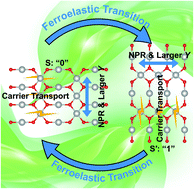First-principles prediction of ferroelasticity tuned anisotropic auxeticity and carrier mobility in two-dimensional AgO†
Abstract
Two-dimensional (2D) materials integrated with anisotropy and ferroelasticity are highly desired for controllable polarization-sensitive devices and ferroelastic memorizers but are rarely reported. Herein, using the particle swap optimization (PSO) method and first-principles calculations, we theoretically predicted the coexistence of single-direction auxeticity, anisotropic carrier mobility, and intrinsic ferroelasticity in 2D silver oxide (AgO). Linear and square–planar Ag–O ligands align vertically in 2D AgO, leading to remarkable in-plane anisotropy. 2D AgO exhibits a large out-of-plane negative Poisson's ratio (NPR) of −0.47 which can only be triggered by the uniaxial strain along the y-direction. The electrons/holes favor the transport along the x-direction with mobilities of up to ∼6000/4000 cm2 V−1 s−1, which is around 10/17 times higher than that along the y-direction. Moreover, a strain-driven 90° lattice rotation is found in 2D AgO with a record high reversal strain of 107.6%. Such integration allows us to tune the direction of the anisotropic properties, and at the same time enables the efficient identification of the bi-stable states during the ferroelastic transition, thus promising the versatile applications of 2D AgO in controllable mechanic/electronic devices and non-volatile information storage.



 Please wait while we load your content...
Please wait while we load your content...